A Fresh Crop of Gastronomy Students

We are looking forward to welcoming a fresh crop of Gastronomy students to Boston University this fall. Here is the final batch of their bios and photos. We hope you have enjoyed getting to know them!
Alex DiSchino is a first generation American from an Italian family who at a young age  developed a love of food by spending hours in the kitchen with his Aunts and furthered his passion by working in multiple roles in restaurants (from line cook to waiter) before heading off to college. Originally from South Florida, Alex has been a Boston resident for the past 10 years ever since he moved to get his BSBA in Marketing from Northeastern University. Alex’s career has led him through roles where he has gained a strong background in consumer electronics and CPG food industries. With these skills in product marketing, development, and management Alex aims to continue to leverage his skills in developing commercially viable products but adjust his focus toward developing meaningful and successful food products or experiences. He sees the Master of Liberal Arts in Gastronomy program as a once in a lifetime opportunity to share his experiences with a community of likeminded individuals who have a common goal and love for food and it’s importance to our culture and society.
developed a love of food by spending hours in the kitchen with his Aunts and furthered his passion by working in multiple roles in restaurants (from line cook to waiter) before heading off to college. Originally from South Florida, Alex has been a Boston resident for the past 10 years ever since he moved to get his BSBA in Marketing from Northeastern University. Alex’s career has led him through roles where he has gained a strong background in consumer electronics and CPG food industries. With these skills in product marketing, development, and management Alex aims to continue to leverage his skills in developing commercially viable products but adjust his focus toward developing meaningful and successful food products or experiences. He sees the Master of Liberal Arts in Gastronomy program as a once in a lifetime opportunity to share his experiences with a community of likeminded individuals who have a common goal and love for food and it’s importance to our culture and society.
Christy Soojung Sung was born in Seoul, Korea. In May 2014 she completed a BA in  International Relations with a concentration in Conflict Resolution at the George Washington University. From there, she worked at CJ as a business strategy analyst for 2 years. At CJ, she began to cultivate her career in the health and wellness industry and realized that her real interests were stemming from topics about food. She started talking about food and health on her Youtube channel that she started in college. As she continued to talk about food, she felt compelled to pursue a career in the food industry and wanted to learn more about it. When she found out about the Gastronomy program, she was eager to dive straight in.
International Relations with a concentration in Conflict Resolution at the George Washington University. From there, she worked at CJ as a business strategy analyst for 2 years. At CJ, she began to cultivate her career in the health and wellness industry and realized that her real interests were stemming from topics about food. She started talking about food and health on her Youtube channel that she started in college. As she continued to talk about food, she felt compelled to pursue a career in the food industry and wanted to learn more about it. When she found out about the Gastronomy program, she was eager to dive straight in.
She also has experience working for the World Wide Fund for Nature (WWF) for a year as a marketing officer, which is where she developed her passion for sustainable environments and systems.
Christy is interested in Food Policy and Food Business, but in general she is excited to absorb all topics that are related to food such as sustainable food systems, food trends and its history, how a food business works, and topics in nutrition. She is confident that this will be the start of the most exciting chapter of her life.
 Kelli Smith was born and raised in Dayton, Ohio. After a childhood spent in grandmother's kitchens and watching more Rachel Ray than Rugrats, she developed a love for all things food (especially eating it).
Kelli Smith was born and raised in Dayton, Ohio. After a childhood spent in grandmother's kitchens and watching more Rachel Ray than Rugrats, she developed a love for all things food (especially eating it).
During her time at Miami University working toward a BA in International Relations and Latin American Studies, she had the opportunity to study abroad with Semester at Sea. While visiting over thirty countries and taking a course on the Anthropology of Food, she realized this interest might be more than just a hobby.
With a Master's in Gastronomy Kelli hopes to combine her passions of writing, travel and food into a career, how exactly? That's still to be determined. Whether it be through a blog or magazine, her main goal in life is to fill her passport and fill her stomach at the same time.
Announcing the Fall 2017 Pépin Lecture Series in Food Studies and Gastronomy
Boston University's Programs in Food and Wine and MLA in Gastronomy Program are pleased to announce the following lectures scheduled for the Fall 2017 semester. Lectures in the Pépin Series are free and open to the public, but registration with Boston University’s Programs in Food and Wine is required.
The Cooking Gene, with Michael Twitty
Tuesday, October 24 at 6pm
College of Arts and Sciences, 725 Commonwealth Ave, Room 224
Renowned culinary historian, Michael W. Twitty, offers a fresh perspective on our most divisive cultural issue, race, using the popular but complicated lens of Southern cuisine and food culture. To do so he traced his ancestry—both black and white—through food, from Africa to America and slavery to freedom. Southern food is integral to the American culinary tradition, yet the question of who "owns" it is one of the most provocative touch points in our ongoing struggles over race. His mission, to re-create the culinary genius of Black colonial and antebellum chefs sits side by side with revealing truth that is more than skin deep—the power that food has to bring the kin of the enslaved and their former slaveholders to the table, where they can discover the real America together.

Food on the Page, with Megan Elias
Wednesday, November 8 at 6pm
College of Arts and Sciences Building, 725 Commonwealth Ave, Room 224
What’s in a cookbook? More than repositories of recipes, cookbooks play a role in the creation of taste on both a personal and national level. From Fannie Farmer to the Chez Panisse Cookbook to food blogs, American cookbooks have commented on national cuisine while also establishing distinct taste cultures. In Food on the Page, Megan Elias explores what it means to take cookbooks seriously as a genre of writing that is as aspirational as it is prescriptive.

Remembering German-Jewish Culture through its Culinary Traditions, with Gabrielle Rossmer Gropman and Sonya Gropman
Wednesday, November 29 at 6pm
College of Arts and Sciences, 725 Commonwealth Ave, Room 224
What happens to a food tradition when its culture starts to vanish? The advent of the Nazi era brought about the demise of 1000 years of Jewish life in Germany and its cuisine, which differs greatly from the Eastern European one that is generally the accepted definition of Jewish food. This food tradition lives on in the kitchens of some German Jews and in the memories of many others around the world. This talk, by a mother-daughter author team with a German-Jewish background, will address issues of food and memory, food as cultural identity, and preserving and documenting traditional recipes.

- “The German-Jewish Cookbook: Recipes and a History of a Cuisine" by Gabrielle Rossmer Gropman and Sonya Gropman, Brandies University Press
A Fresh Crop of Gastronomy Students for fall 2017

It is just about back-to-school season, when the Gastronomy Program will welcome a new group of students.. Here a fresh batch of their bios and photos. Enjoy getting to know them!
Ariana Gunderson grew up in the Boston area and looks forward to returning for her  Gastronomy MLA at BU. After graduating with a BA in Egyptology from Brown University, Ariana biked to brunch as often as possible while working in DC as a strategy consultant. She then completed a yearlong State Department fellowship in Germany, studying anthropology and excavating a medieval castle. Most recently, Ariana lived in Mexico City, where she continued her consulting work and ate many a tamal. While at BU, Ariana hopes to study refugee and migrant foodways.
Gastronomy MLA at BU. After graduating with a BA in Egyptology from Brown University, Ariana biked to brunch as often as possible while working in DC as a strategy consultant. She then completed a yearlong State Department fellowship in Germany, studying anthropology and excavating a medieval castle. Most recently, Ariana lived in Mexico City, where she continued her consulting work and ate many a tamal. While at BU, Ariana hopes to study refugee and migrant foodways.
 Originally from a small bilingual mill town in Northern Maine on the border of French-speaking Canada, Justine Martin inherited her deep love of food and bringing people together from her grandmother. Over seemingly endless buffets of food at countless holidays, family gatherings, and town celebrations, she saw how her grandmother’s French Acadian cooking brought people from all walks of life together.
Originally from a small bilingual mill town in Northern Maine on the border of French-speaking Canada, Justine Martin inherited her deep love of food and bringing people together from her grandmother. Over seemingly endless buffets of food at countless holidays, family gatherings, and town celebrations, she saw how her grandmother’s French Acadian cooking brought people from all walks of life together.
It was this upbringing and her relationship with her grandmother that first sparked her interest in the powerful role food plays in our lives and in our interactions with others—next door and around the globe. Now, Justine spends nearly all of her spare time cooking, eating, researching, and talking about food and is excited to join the Gastronomy program this fall to connect with others who share her passion. In bringing together her love of food, writing, and culture, she seeks to contribute to the world of food writing and journalism in a unique and meaningful way.
Justine earned her undergraduate degree in Elementary Education from the University of Maine at Fort Kent and spent two years as a 2nd grade and health teacher in Southern Maine. She then moved to the Boston area, where she works as a university development writer and lives with her husband and two fur balls: Ambrose, the moody yet secretly affectionate cat, and Mabel, the crazy-pants clown of a Boston Terrier.
Meghan Russell grew up in Pittsburgh, Pennsylvania and went to Penn State University, graduating with a degree in History. Since then she has lived in Washington D.C. and Boston working in consulting and technology.
graduating with a degree in History. Since then she has lived in Washington D.C. and Boston working in consulting and technology.
Meghan always enjoyed helping in the kitchen and going to the grocery store and famers market with her mom growing up, but her passion for food really took off after graduating college. After years of cooking for friends and family, she started her own blog (vegetableway.com) a few years ago as a way and is excited to get back to posting on it more regularly.
As a way to get more involved in food advocacy issues, she started volunteering at the Daily Table, a grocery store in Dorchester, MA. At BU Meghan plans to focus on policy and business, looking for ways to address food access issues and promote local, sustainable food choices through awareness and education.
Welcome, new Gastronomy students!

It is just about back-to-school season, when the Gastronomy Program will welcome a new group of students.. Here a second batch of their bios and photos. Enjoy getting to know them!
 Ashley Lopes grew up in San Francisco, California and earned her undergraduate degree in Hospitality and Tourism Management at New York University. As a food enthusiast with a bottomless stomach for carbs, she enjoys watching cooking shows and making food from scratch. While at NYU, Ashley wrote and edited content for culinary magazines and interned in restaurant kitchens and at the Institute of Culinary Education. Most memorably, she tested and evaluated kitchen appliances as a test kitchen intern at Good Housekeeping Magazine.
Ashley Lopes grew up in San Francisco, California and earned her undergraduate degree in Hospitality and Tourism Management at New York University. As a food enthusiast with a bottomless stomach for carbs, she enjoys watching cooking shows and making food from scratch. While at NYU, Ashley wrote and edited content for culinary magazines and interned in restaurant kitchens and at the Institute of Culinary Education. Most memorably, she tested and evaluated kitchen appliances as a test kitchen intern at Good Housekeeping Magazine.
After graduating, Ashley worked at a startup in Cape Town, South Africa, before directing her passion for travel to a full-time career at TripAdvisor. Since then, she's traveled extensively and seen first-hand how food and culture intersect. Most recently, she ventured on a solo backpacking trip through the vibrant food scenes of Southeast Asia and through the spectacular mountains and fjords of New Zealand.
Ashley is excited to move to Boston and join the Gastronomy Program at BU, where she aims to combine her love of food with writing and travel. She looks forward to studying food on a deeper level and connecting with like-minded foodies. Her goal is to pave a meaningful and colorful career in food publishing and culinary tourism.
 Norma Tentori’s fascination with food has been kindled from a young age in Central America where she grew up constantly involved in the kitchen during meal preparation, thanks in great part to her Hispanic and Italian family’s passion, appreciation, interest and enticing diversity in food culture. From there, she called Boston home as she completed her BSBA this past spring in Business Administration with a minor in Nutrition at Simmons College.
Norma Tentori’s fascination with food has been kindled from a young age in Central America where she grew up constantly involved in the kitchen during meal preparation, thanks in great part to her Hispanic and Italian family’s passion, appreciation, interest and enticing diversity in food culture. From there, she called Boston home as she completed her BSBA this past spring in Business Administration with a minor in Nutrition at Simmons College.
As her next career move, she wants to deepen her knowledge in a field that is perfectly aligned with her interest in food, its industry and its prospects in business. She was thrilled to encounter that there is such a program at BU, combining graduate studies in gastronomy and entrepreneurship, right in the city that she has always loved. Norma is confident that this master will satisfy her craving for expertise in gastronomy, as well as provide her with the skills required to intertwine this expertise with brand building and marketing success with a focus in the food / beverage industry
A Fresh Crop of Gastronomy Students

We are looking forward to welcoming a fresh crop of Gastronomy students to Boston University this fall. Here is the first batch of their bios and photos. Enjoy getting to know them!
Becca Berland is a self-proclaimed ice cream aficionado who was born and raised in  Sylvania, Ohio. She attended the University of Pittsburgh and graduated in 2016 with a Bachelor’s degree in Linguistics and minors in French Studies and Religious Studies. During her four years at Pitt, Becca acted as Editorial Director of Pitt's chapter of Spoon University, as well as a National Editorial Intern and Elite News Team Member for Spoon HQ in NYC. After she spent a summer interning for Delicious Israel, an Israeli culinary food tour company based out of Tel Aviv, Becca realized that pursuing a career in food media was basically inevitable.
Sylvania, Ohio. She attended the University of Pittsburgh and graduated in 2016 with a Bachelor’s degree in Linguistics and minors in French Studies and Religious Studies. During her four years at Pitt, Becca acted as Editorial Director of Pitt's chapter of Spoon University, as well as a National Editorial Intern and Elite News Team Member for Spoon HQ in NYC. After she spent a summer interning for Delicious Israel, an Israeli culinary food tour company based out of Tel Aviv, Becca realized that pursuing a career in food media was basically inevitable.
Currently working out of Boston as a Social Media/Content Manger for one of the top fitness coaches in the country, Becca is thrilled to join the Gastronomy program at BU where she can connect with like-minded food enthusiasts (have we mentioned that she named her dog Basil?). Becca plans to hone in on her writing skills in hopes of one day becoming the editor of a food magazine.
Mollie Braen was born and raised in Los Angeles, California. She graduated with a BA in  Art History in the spring of 2015 from the University of Denver and spent her final semester studying abroad at the University of Glasgow in Glasgow, Scotland. Mollie, an avid traveler, eater and cook, moved to Boston in 2015 to pursue work in the art and non-profit community. But her passion and true love was always food, wine and beer. Mollie will be pursuing her masters in gastronomy, concentrating on food policy and business. Her goal is to gain knowledge about the current and past agricultural climate in the United States and to use this comprehensive liberal arts degree to work within the progressing tech and biomedical fields to create healthier, more accessible, and organic produce and products for all. She currently lives in Cambridge with her very funny and mischievous cat, enjoys eating any and all cheeses and is excited to be back in school.
Art History in the spring of 2015 from the University of Denver and spent her final semester studying abroad at the University of Glasgow in Glasgow, Scotland. Mollie, an avid traveler, eater and cook, moved to Boston in 2015 to pursue work in the art and non-profit community. But her passion and true love was always food, wine and beer. Mollie will be pursuing her masters in gastronomy, concentrating on food policy and business. Her goal is to gain knowledge about the current and past agricultural climate in the United States and to use this comprehensive liberal arts degree to work within the progressing tech and biomedical fields to create healthier, more accessible, and organic produce and products for all. She currently lives in Cambridge with her very funny and mischievous cat, enjoys eating any and all cheeses and is excited to be back in school.
Born and raised in New Jersey, Carolyn Grillo moved to Boston to attend college. She  graduated with a BS in Studio Art from Boston College and then attended culinary (pastry) school in Paris, France at Le Cordon Bleu. When Carolyn returned from Paris she worked as a baker at Flour Bakery + Cafe in Boston for two years. Carolyn has been working at America's Test Kitchen in the Tastings and Testings department for the last two years. Carolyn's job affords her the opportunity to work in different areas of the company including both print and online content, television, and cookbooks. As time progresses Carolyn has become more interested in the business side of the food industry. Through this experience Carolyn hopes to expand her knowledge, challenge herself, and gain tools to progress in her career.
graduated with a BS in Studio Art from Boston College and then attended culinary (pastry) school in Paris, France at Le Cordon Bleu. When Carolyn returned from Paris she worked as a baker at Flour Bakery + Cafe in Boston for two years. Carolyn has been working at America's Test Kitchen in the Tastings and Testings department for the last two years. Carolyn's job affords her the opportunity to work in different areas of the company including both print and online content, television, and cookbooks. As time progresses Carolyn has become more interested in the business side of the food industry. Through this experience Carolyn hopes to expand her knowledge, challenge herself, and gain tools to progress in her career.
Swarnata Prabhu was born and raised in Mumbai, a city known for its culinary indulgence and abundance of savors. She believes her childhood had a huge impact and influence in her relationship with food, as there was a lot of cooking, eating and entertaining at home.
Swarnata earned her Bachelor’s in Management Studies from the University of Mumbai  and then went on to pursue her graduate degree in Human Resources and Industrial Relations at the University of Minnesota to attain an international perspective in her field. She worked for a few years as a human resource professional and then decided to take a break to spend time with her family. During this period, she not only reconnected with her hometown Mumbai, she also decided to pursue her passion. Swarnata started her home based baking venture in Mumbai and went on to learn pastry arts from finest pastry Chefs in India. She says her culinary journey has just started. Swarnata has worked in the pastry department of a five star hotel in India, mentored and taught culinary students, indulged in food photography and explored unusual food sources (protein packed bugs in Cambodia). She not only enjoys experiments in her kitchen but has utmost fun eating, exploring and learning about new foods.
and then went on to pursue her graduate degree in Human Resources and Industrial Relations at the University of Minnesota to attain an international perspective in her field. She worked for a few years as a human resource professional and then decided to take a break to spend time with her family. During this period, she not only reconnected with her hometown Mumbai, she also decided to pursue her passion. Swarnata started her home based baking venture in Mumbai and went on to learn pastry arts from finest pastry Chefs in India. She says her culinary journey has just started. Swarnata has worked in the pastry department of a five star hotel in India, mentored and taught culinary students, indulged in food photography and explored unusual food sources (protein packed bugs in Cambodia). She not only enjoys experiments in her kitchen but has utmost fun eating, exploring and learning about new foods.
Swarnata feels confident that the gastronomy program at Boston University will equip her with a fulfilling career in the ever changing and challenging food world. She wants to focus on food policy and communications to make an impact as a food advocate, chef and educator.
The Importance of Hospitality in Kazakhstan
We continue our series of posts from the Anthropology of Food class (ML 641) in which students reflect on current issues, discuss assignments they have worked on, or address topics of particular interest to them. Today’s post is from Kaitlin Valli.
When I first started looking into Kazakhstan for my final project, I wasn’t sure what I’d find—I chose it a bit haphazardly, simply because the country was huge and I had realized, looking at the map, that I knew almost nothing about it. But as I looked into it, I was interested to see that a strong culture of hospitality developed there centuries ago and is still an identity marker today. The importance of sharing food and drink is a common theme across cultures, of course, but in Kazakhstan it seemed to take on another level of significance. The Kazakh language has dozens of words for different types of guests, and many proverbs referring to the blessing a guest brings to the family, which range from reverent (“If a guest comes, abundance comes with him or her”) to cautionary (“A guest sits briefly, but notices a lot”) to outright threatening (“If you don’t accept the guest, there won’t be any happiness or abundance in your home.”)

That a culture of being a good host and gracious guest evolved makes practical sense—back when people were nomadic and spread across the vast steppe, it was wise to be generous with a visitor, as a host did not know when they would need that same kind of hospitality themselves. But a guest was more than that—a visitor also meant entertainment and an excuse for a feast, as well a very necessary connection to the outside world. A guest was harbinger of nourishment of all kinds.
The russification of Kazakhstan means that even today, after attempts at language revival, only 74% of its citizens understand the spoken Kazakh language, while 94% understand Russian (Lillis 2017). And yet, after years of adapting to Soviet rule, the traditional value of hospitality persists. It has become a deeply intertwined aspect of Kazakh identity and culture, to the point where the ability to be a good host or hostess is considered an important criteria for judgment.

Though the importance of hospitality has persisted, the customs around hospitality have naturally changed over time. Today, to cut down on time required, Kazakh women may turn to prepared foods instead of making their own, and alcohol consumption has decreased as a result of the increased cost of entertaining. But though traditions have evolved, especially in big cities, they are still vital. Guests should not leave without having at least tasted the meal offered, and hosts will at the very least offer tea. Using beautiful dishware is still common, and hosts will pour a little tea at a time, as pouring a large cup at once would signify that they want their guest to leave sooner.
The studies and ethnographies I encountered conclude the same thing—Kazakh people “cannot live without hospitality, without guests, without a table set and ready to receive guests” (Charkyroglu 2014, 127). But I think a woman profiled in one of my readings expressed it best: “If you can’t make a big party to celebrate your son’s engagement, then why live on this earth” (Michaels 2007, 157)?
Works cited:
Chakyroglu, Altynshash Kurmanali, and Botagoz Suiyerkul. 2014. “Representation of the Concept “Hospitality” in the Kazakh Language.” Procedia Social and Behavioral Sciences 136: 124-128.
Lillis, Joanna. 2017. "Kazakhstan: Astana Wants Kazakhstanis to Speak Kazakh." EurasiaNet.org. Accessed July 21, 2017. www.eurasianet.org/node/62424
Michaels, Paula. 2007. “An Ethnohistorical Journey through Kazakh Hospitality.” In Everyday Life in Central Asia: Past and Present, ed. Jeff Sahadeo and Russell Zanco, 145-159. Bloomington: Indiana University Press.
Course Spotlight: Food and Society
Dr. Karen Metheny will teach Food and Society (MET ML 712) on Thursday evenings during the fall 2017 semester, and has prepared this overview of the class.
»How do social institutions shape the way we think about food? Our ability to access food?
»How do work schedules and family dynamics shape or constrain the family meal?
»Do social classes and institutions affect the way we shop? The food we prefer?
In Food and Society, students will examine these kinds of questions and look specifically at how social groups, categories, and institutions shape, structure, or are structured by food-related practices. We will look at multiple contexts of food production, access, procurement, and consumption, including rural agricultural sites, urban homesteads, grocery shopping, CSAs, and food assistance programs. We will also examine the intersection of food practices with class, ethnicity, race, age, and gender.
We will engage in a range of exercises to explore methods (visual sociology, food chain analysis, surveys and questionnaires, interviews) that can be applied to a final research project. The research project offers students a wonderful opportunity to pursue in-depth analysis of key topics in food studies. A sample of past projects includes:
- focused analysis of the role of ethnic food trucks as potential agents of taste expansion, authenticity, or cultural appropriation
- food as cultural capital among millennials
- a comparative study of Haymarket and Boston Public Market in the context of creating social well-being and a 'sense of community'
- the mission and sustainability of The Daily Table
- the food landscape of Jamaica Plain
- imagined kitchenspace
- dinner on demand services as cultural capital
- functional foods and grocery shopping through the lens of yogurt

Students have utilized Pinterest, Snapchat and Instagram as sources of data, conducted surveys through Facebook, created photo essays and videos, and collected oral interviews to complete their projects. Students will also have the opportunity to hear from a number of area food scholars and activists, and we will work with Dr. Bob Cadigan from the Applied Social Sciences department to create and implement surveys and questionnaires. Hope to see you in class!
MET ML 712, Food and Society, will meet on Thursday evenings from 6:00 to 8:45 pm, starting on September 7, 2017. Registration information can be found here.
Night Markets and Cultural Identity
Gastronomy Student Celine Glasier shares this post in our series “Perspectives from Anthropology of Food.”
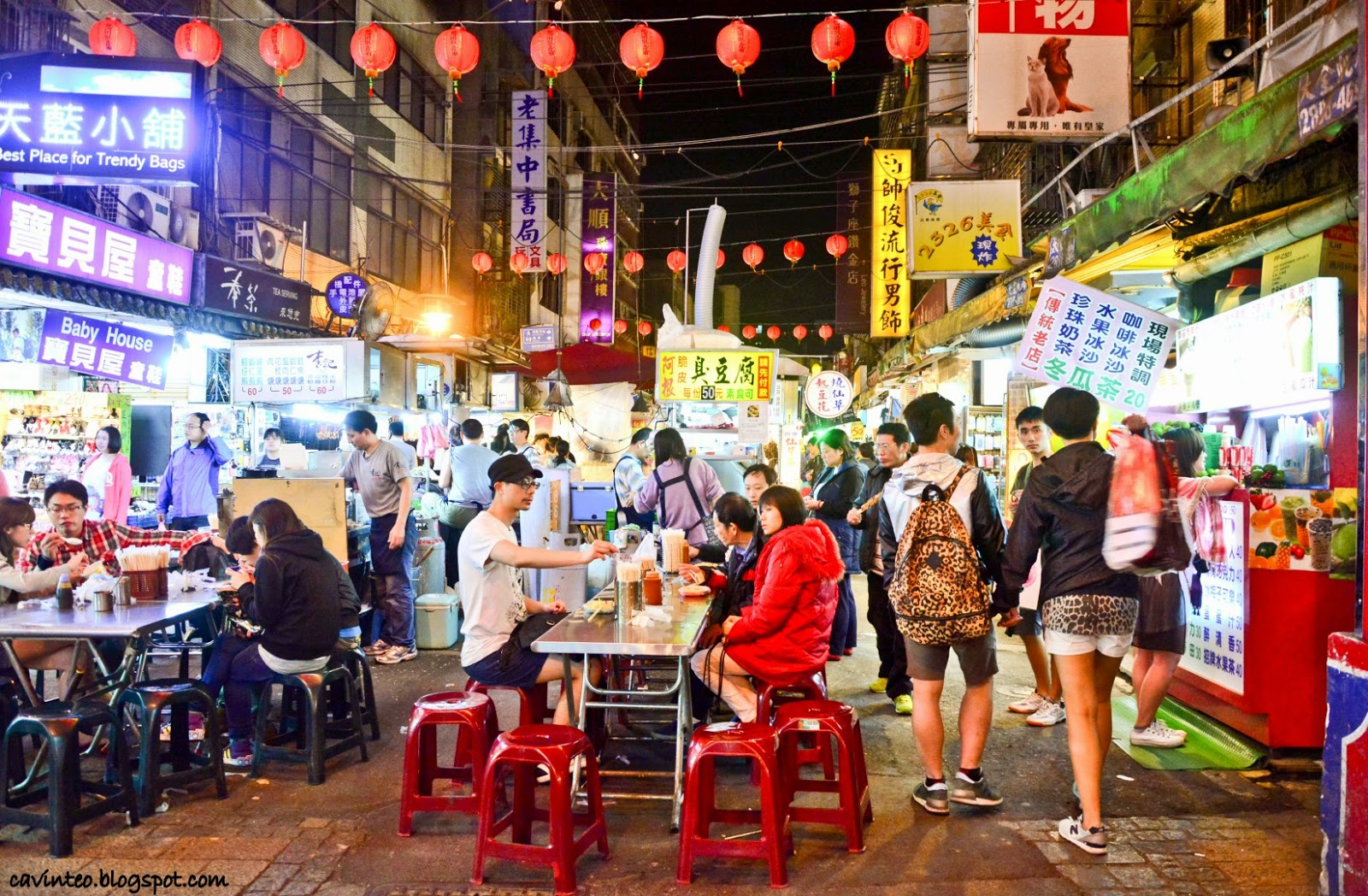
My grandmother lives in a very small town in the south of France called Montauroux. It's a little, quaint community that is nestled on top of a hill. There are outdoor cafes in the town center where elderly men spend their days and evenings playing pétanque, bi-weekly farmers markets, and peach orchards near-by for warm weather picking. My memories of the summers when I’d come to visit her are filled with ice cream and swimming in the nearby Mediterranean Sea. But what excited me the most about my summer visits to my grandmother’s was the open air night markets that would take place in the adjacent larger cities. Every Thursday night in July people would come together to sell their goods and socialize with each other. Each town had a different location for their markets, but they usually took place along the waterfront, with an occasional short firework display. It was the way to celebrate the summer. I remember being seven years old and feeling excitement and anticipation all day long when my grandmother would take me. And as soon as we left, I’d ask to go again next week.
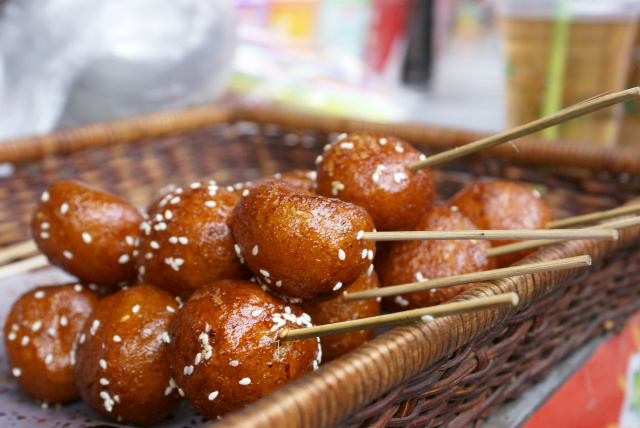
Researching global night market trends for Anthropology of Food, I discovered that many cultures organize night markets. Taiwan’s proliferation and popularity of night markets is especially interesting. There are hundreds of night markets in Taiwan, and each offers its own version of snack foods called xiaochi (or small eats). Xiaochi are considered one of the most authentic forms of Taiwanese foods, and like markets themselves, there are hundreds of them. They typically come fried, or in a soup broth, or on a stick, are small, bite-sized, and generously seasoned with condiments. A chef in Taiwan named Chuang Pao-hua is preserving the art of xiaochi and Taiwanese cuisine by teaching locals and foreign student how to cook xiaochi with gu zhao wei (the Taiwanese traditional flavor preserved through generations of recipes).

Xiaochi are unique because they not only represent cultural identity but, for the most part, they are found solely in night markets. The originating market to which they belong is also where you can find the most authentic version, and local towns or provinces are often named after the local xiaochi dishes they serve. You can go to a night market in Taipei, and another in Tainan, and find different and distinct versions of xiaochi that embody the local flavor.
But what really drew me to understanding night markets in Taiwan was the energy they epitomize and the transformation of local space through them. Because they are often hot, crowded, and loud, night markets generate an energetic quality known as renao. Renoa translates into “a manifestation of the human flavor that is generated through enthusiasm and human interactions” (Yu 2006, 132). It’s the collective human energy you get when the senses are heightened and life is being enjoyed.
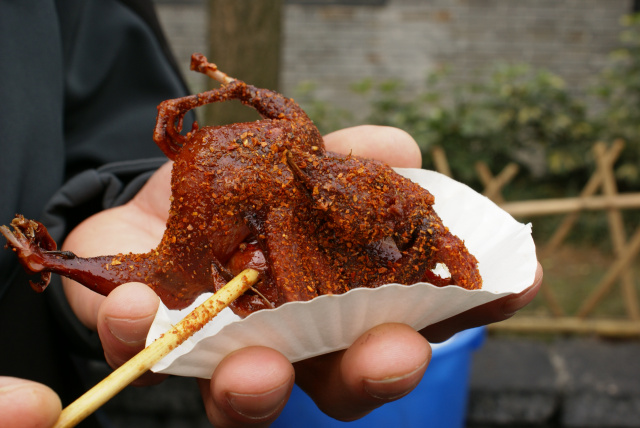
In this altered atmosphere, people can ignore cultural rules for appropriate behavior, are allowed to act leisurely, and become renewed through experiencing pleasure in their daily life. People act at ease. Night markets provide a sensorial experience similar to that from participating in a religious space. In a church or temple, your senses are altered through incense or various smells, meditation, organ music, and colorful visual representations or statues. Night markets alter your senses as well, and stepping into one, you enter another world.
Night markets are also important because they serve as a place for public activity and socialization. The energy that transforms a space that’s designated for one purpose during the day serves a different purpose at night. In Taiwan, the night is a time for socializing. Walking through night markets is one of the most popular nighttime activities in Taiwan, as it is a chance to be seen by others and satisfy social needs. Through the experience of heightening the senses of taste, sound, and tactile heat, from cooking and from other bodies, night markets serve as a means of communicating Taiwanese identity, socialization and commensality. As an ethnic group, gathering communally allows for communicating traditions, folklore, values, and cuisine. Night markets are one way that Taiwanese culture has been able to create a divergent culture and preserve identity. Night markets and xiaochi are a way of proliferating and preserving authentic Taiwanese culture. They are for the people.
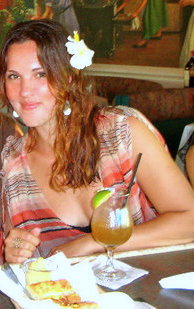
When I think back now on the night markets I went to with my grandmother, I realize that part of their appeal was the vastness and richness of colors and smells. The scent of roast chicken skewers, corn grilling, and fresh breads and sugary pastries mixed with the sea breeze, the sounds of people congregating and conversing, and the sight of colorful snack foods and icy summer drinks are all deeply embedded in my memory. It was a place in which I was allowed to indulge myself and forget the rules. So what if I had two desserts? Under the cloak of the night, and with my grandmother, different rules applied.
Works cited:
Yu, Shuenn-Der. 2004. “Hot and Noisy.” In The Minor Arts of Daily Life: Popular Culture in Taiwan, ed. David K. Jordan, Andrew D. Morris, and Marc L. Moskowitz, 129-149. Honolulu: University of Hawaii Press.
Xiao-chi images from https://xmarxchicago.wordpress.com/2011/03/21/xiao-chi/
Food Mapping of Mini Social Media Mavens: Exploring YouTube with an Ethnographic Eye
Gastronomy student Corrine Williams provides another example of food mapping in our next post in our series "Perspectives from Anthropology of Food."
In the age of the internet, social media seems to gain more cultural significance every second. Images have always been integral to media, and with Instagram’s popularity it’s clear people enjoy the content. The grouping and context are important for the meaning embedded in the images as well. Anthropologists and ethnographers have known this for decades and have used images that have been submitted by participants in studies to make connections about individuals’ realities and the larger collective cultural beliefs. Food maps are another tool that track food procurement and production of food. With social media the content is self propagated and can be the subject of scholarly study. People are performing these carefully constructed identities on various platforms to qualify and classify themselves, intentionally or unintentionally. In Food and Social Media: You are What You Tweet (2012), author Signe Rousseau states that food’s popularity has only been amplified by social media, bringing people together in new ways.
Using social media, YouTube more specifically, I studied a family that video blogs and applied my budding ethnographic eye to analyze their foodways. The food map of the ‘M’ family shown is an abstract representation of their home and the gendered space and labor within the household. Five videos are food-focused. One of the main videos showcasing the family cooking meals at home is a sponsored video by Hello Fresh; its effect is to show how the company makes cooking so easy that even ‘Dada’ can do it. The title of the video, “Dad tries to cook for twins,” insinuates that he is not going to be successful. In contrast, the title of the video with the mother at the helm is “The girls cook for the baby,” a more declarative positive, and a gendered message. This communication between the parents and the twins is a fun way to engage the girls, get good reactions for the camera, and help the girls learn, but it also reinforces gendered knowledge. In another video when the twins are being interviewed, there is a hanging question, and the response is my dad doesn't know how to cook, only my momma cooks, my sister cooks and I cook.
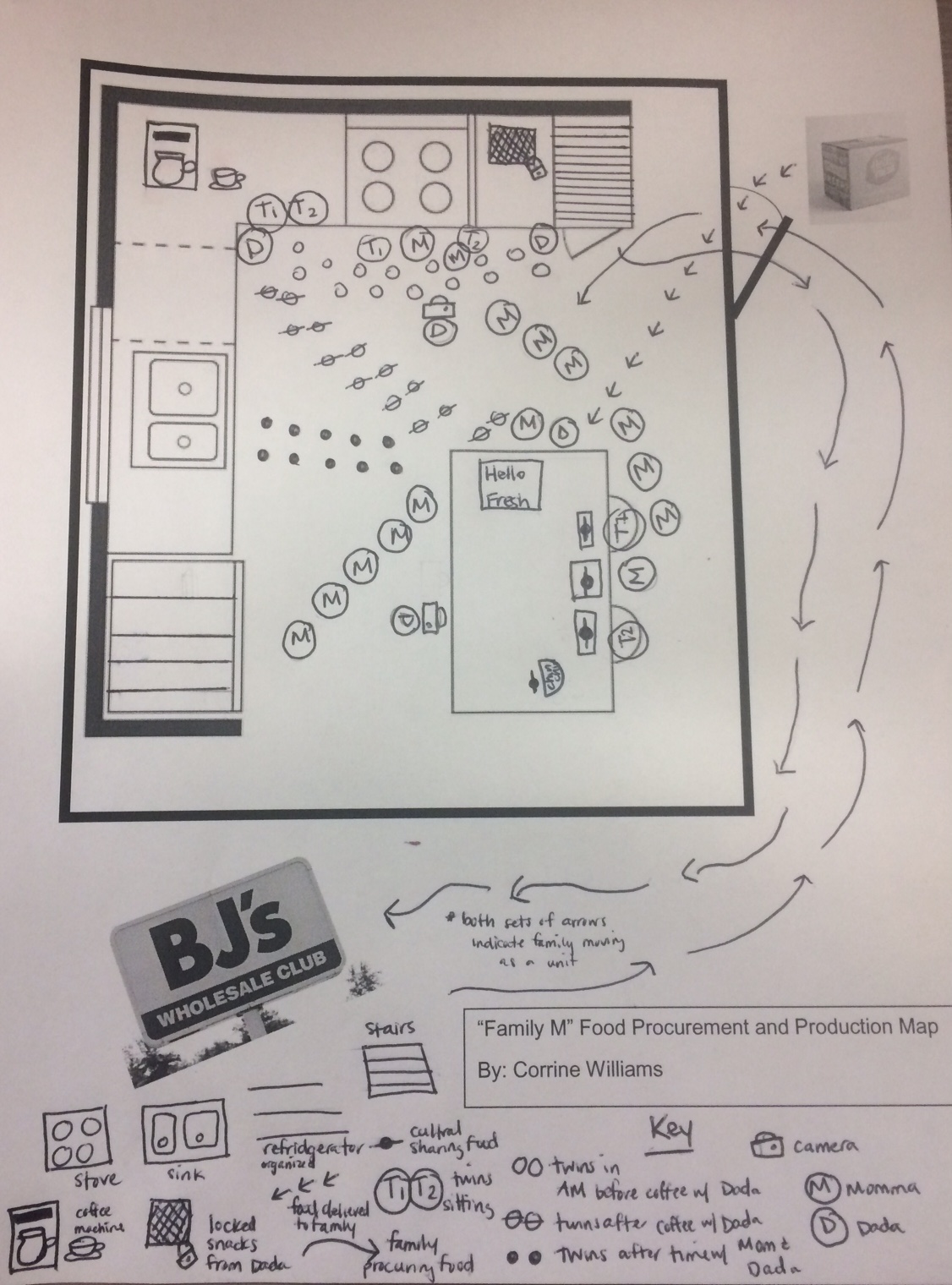
Dada can make coffee, which he does with the girls each morning. He uses the time while the coffee is brewing to teach the girls about various things; in the video, he shows them octopi. The title of that video is “Father teaches daughters how to make memories.” Coffee has a powerful smell, so the father is distinguishing himself as a coffee drinker, in opposition to his wife as a tea drinker. He is also establishing himself in the girls’ memories through the sensory activities of smelling the coffee as it brews.
Momma is doing her best to pass on an embodied knowledge and sensory memory too. She is communicating the importance of their shared cultural food. The three ladies prepare a Nigerian snack, chin chin, together. It is interesting to see that both parents have separate food production times with the girls; through these actions, each parent is trying to make memories, but also impart some of their identities onto the girls because they are half of each parent. The parents are establishing traditions and structure with food to make memories and allow the girls to express themselves and explore their unique multifaceted identity.

On the surface, this family is making meals and memories and capturing these activities on video, but looking deeper, they are using media as a social construction, an action that speaks volumes about their values and how they choose to represent themselves to the world wide web. I really enjoyed this project. It encouraged me to look at everyday life and pull apart the layers of significance to understand the connections. Perhaps I will start a food vlog and talk about other food vlogs in this context. With my new mindset, I’m sure I will subscribe to the same themes and methods that I analyze other blogs for, and hopefully people will subscribe to my vlog to perpetuate this cycle. In the world of YouTube, videos speak louder than words and we should take them with a grain of salt.
Works Cited
Rousseau, Signe. 2012. Food and Social Media: You Are What You Tweet. Lanham, MD: Altamira Press/Rowman and Littlefield.
Cacao in Olmec Society
We continue our series of posts from the Anthropology of Food class (ML 641) in which students reflect on current issues, discuss assignments they have worked on, or address topics of particular interest to them. Today’s post is from Gastronomy student Morrisa Engles.
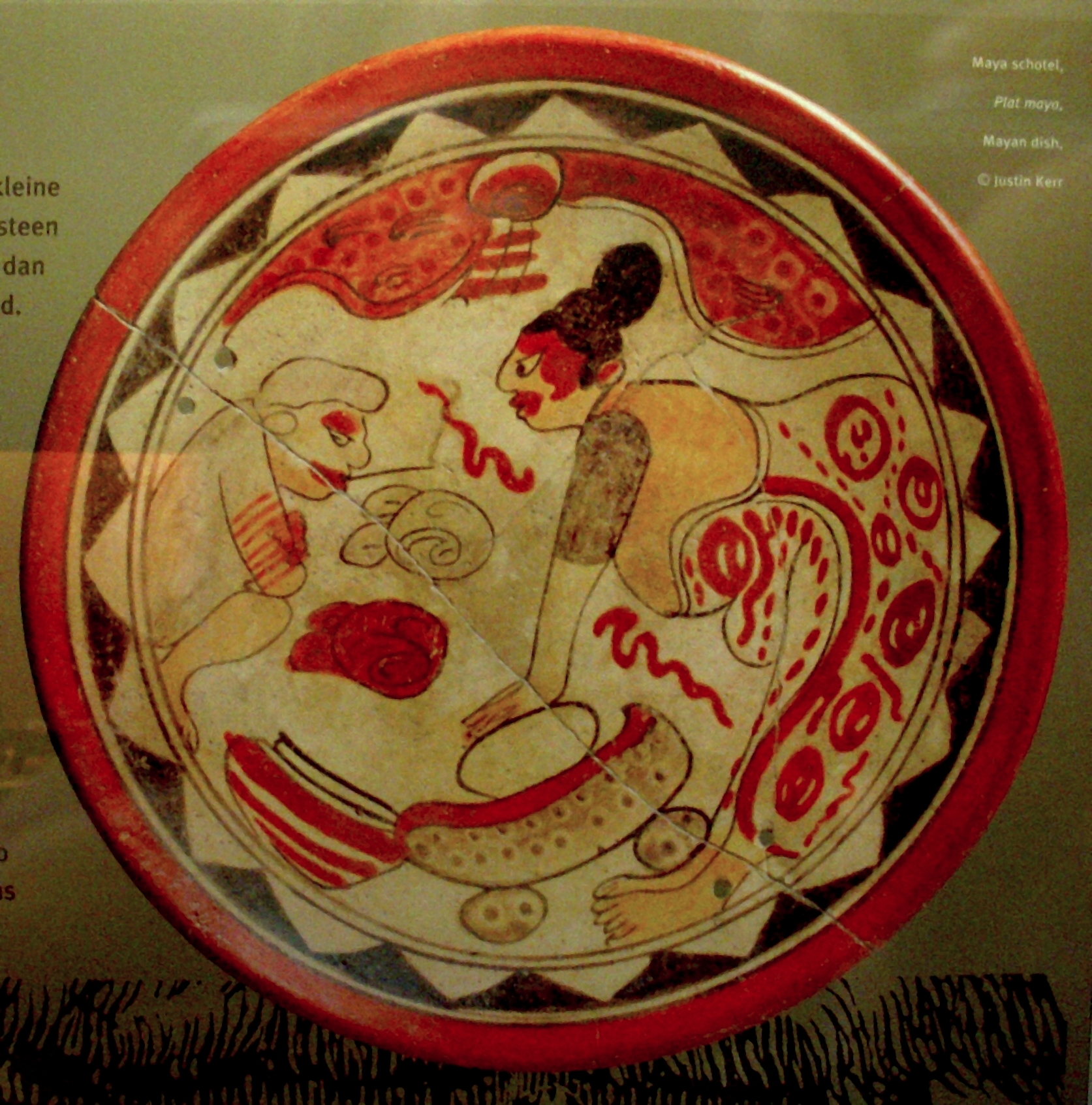
Cacao has carried deep cultural meaning since it was first domesticated. For the Olmec, an early Mexican Gulf Coast culture (1500 to 400 BC), this plant had geological, nutritional, spiritual, and economic significance. As the first society known to have domesticated the cacao tree, the Olmec found the crop to be spiritually and culturally significant in addition to being a healthful and delicious foodstuff. Theobromine (a chemical compound present in cacao) found in excavated Olmec pottery and at ancient burial sites revealed that cacao beverages were a staple in a variety of spiritual ceremonies (Powis 2011).
The question becomes, why cacao? According to the Popol Vuh, the Mayan creation text, the gods created humans from a combination of sweet things, maize, and cacao (Driess and Greenhill 2008, 18-22). In addition, many ancient artifacts depicted cacao offerings between gods such as the Mayan moon goddess IxChel and the rain god Chac who are seen trading cacao in an ancient Mayan depiction. This iconography rooted the tree’s capacity as a conduit of communication with the gods. Known as the “World Tree” or the “First Tree,” this crop became the tree of life and a cosmic metaphor linking the natural world to the spirit world. Thus, the offering of cacao functioned to symbolically connect diviners with the gods through ritual. The bounty of the cacao tree in Mesoamerica also created a metaphorical link to abundance, which was a request to the gods in agrarian and funerary rites. As Driess and Greenhill state, “Obsession with time and calendrical events fueled rituals during which cacao offerings helped to ensure the continuation of cosmic and agricultural cycles” (2008, 52). Cacao drinks were left in tombs and beans were used to adorn the bodies of the dead as it was believed that cacao had the power to energize the soul and aid in the transition to the supernatural world. The deep spiritual meaning of cacao catalyzed its importance in Olmec society.
Generally sought out for religious purposes by the Olmec, cacao didn’t become a food of conspicuous consumption until the Aztec and Mayan eras when cacao was served at feasts, weddings, birth ceremonies and other social occasions (Henderson 2015, 84). As the crop gained exposure, demand was created and soon cacao was present at nearly every commensal dining event, becoming a staple in the Mesoamerican diet. Popularly consumed as a beverage, the Olmec fermented the cacao with pulp intact. In the early days, cacao beverages were produced solely from the pulp of the fruit. The discovery of the more familiar chocolate drink might have been a happy accident as a by-product of the pulp brewing process (Edgar 2010).

After fermentation, cacao beans were mixed with water, vanilla, cinnamon, and sometimes a red chili. The beverage is generally made by women who dutifully raised the foam on the drink before consumption. The foam was thought to contain the essence of the wind god P’ee and still today, the amount of foam raised is a measure of a woman’s worth. After the drink was prepared and the foam was raised, the cacao beverage was ready for use in ceremony or prescribed as a remedy for ailments. Cacao was used to cure skin conditions, fever, seizures and in the most severe matters used to coax illness out of the body by appealing to the spirits with an offering of beans or a blended concoction containing the fruit (Dreiss and Greenhill 2008, 136).
Over time, chocolate has become a beverage enjoyed by cultures all over the world, but cacao was an incredibly significant crop to the Olmec during the Formative Period in Mesoamerica. The abundance, healing, and nutritional properties of the crop made it seem a true gift from the Gods, and created a foundation for its integration into the cultural identity and landscape of Mesoamerica.
Works Cited
Dreiss, Meredith L., and Sharon Greenhill. 2008. Chocolate: Pathway to the Gods. Tucson: University of Arizona Press.
Edgar, Blake. 2010. "The Power of Chocolate." Archaeology 63(6): 20-25. Date of access, June 20, 2017. http://www.jstor.org/stable/41780626.
Henderson, John S. 2015. “Cacao/Chocolate.” In Archaeology of Food: An Encyclopedia, Karen Bescherer Metheny and Mary C. Beaudry, eds., 84-87Blue Ridge Summit: Rowman & Littlefield Publishers. Accessed June 20, 2017. ProQuest Ebook Central.
Pool, Christopher A. 2007. Olmec Archaeology and Early Mesoamerica. Cambridge World Archaeology. Cambridge; New York: Cambridge University Press.
Powis, Terry G., et al. 2011. "Cacao Use and the San Lorenzo Olmec." Proceedings of the National Academy of Sciences of the United States of America 108(21): 8595-600. Date of access, June 20, 2017. http://www.jstor.org/stable/25830997.
